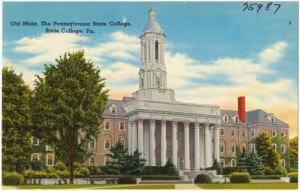Chapter 4: Pennsylvania Academy of Science in the 1930s
The Depression Years (1930s)
Life for the Average Pennsylvanian
During the 1930s, many factories and mines were closed or were operating at reduced capacity, which meant that many people did not have work or worked less. Major cities in the Commonwealth such as Pittsburgh and Philadelphia were the scene of breadlines and soup kitchens were filled to capacity. In the home, many had to make do with less and lived by mending clothes, growing their own food in gardens, and entertaining themselves by listening to the radio and playing board games. The hard times also brought communities together with dances, potluck dinners, and other social events. While these are general perspectives, the experience of somebody in a major city was quite a bit different than that in the rural areas.
Despite the hardship, there were some advancements in technology that made lives better. Listening to the radio became a central feature of the home and automobiles continued to evolve with electric starters and stronger engines. Commercial air travel became more common with TWA and refrigerators and washing machines became more common, especially in the urban areas. The use of plastic became more ubiquitous as the decade progressed.
Science in Pennsylvania
The 1930s in Pennsylvania was marked by the Great Depression, which affected the once-great industries that flourished in the 1920s. In spite of the hardship, science continued within the Keystone state. Some of the most notable discoveries in medicine were made at the Wistar Institute at the University of Pennsylvania in Philadelphia. In 1933, the first medical physics department in the United States was established and was a significant step in integrating physics into medicine, leading to advancements in radiation therapy and imaging. Also during this decade, the Pennsylvania State College, became The Pennsylvania State University.
Changes in the Pennsylvania Academy of Science
The early part of the 1930s saw the formation of the Pennsylvania Junior Academy of Science, which was an effort to provide science education opportunities for high school students of the Commonwealth. Two prominent new committees were started in the Academy during this time, and included the Conservation Committee and the Science Education Standards Committee. Both of these committees led to some of the most visible contributions to science that are still felt today.
Summary of Meetings
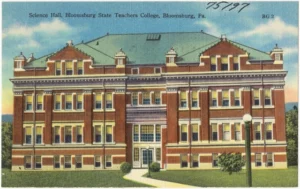
Science Hall at Bloomsburg State Teachers College — Bloomsburg State Teacher’s College – 1930-1945 – Public Domain
6th Annual Meeting – April 18-19, 1930 (Bloomsburg State College, Bloomsburg, PA): At this meeting Dr. Otto Jennings of the Carnegie Museum gave a talk, where he recommended six areas of natural concern be protected in Western Pennsylvania, leading to the Conservation Committee of the Academy. These areas included Presque Isle, Pymatuning Swamp, Mercer Bog, Columbus Bog, Fringed Gentian Fen, and Ohiopyle Peninsula. This also led in part to the formation of the Western Pennsylvania Conservancy in 1933.
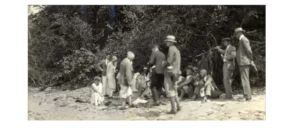
Professor Leighton speaking on the shore of Lake Erie at Presque Isle in 1930 – PA Geological Survey – Public Domain.
Summer Meeting – August 1-2, 1930: The 1930 meeting was held at Presque Isle on Lake Erie to look at the geology and biology of the area.
7th Annual Meeting – April 3-4, 1931 (Senate Caucus Room in Harrisburg, PA): At this meeting, Dr. Norman Stewart of Bucknell University presented a paper on a disease that was killing deer in Pennylvania. In his paper, he stated that the disease had killed 300 deer in Clearfield County. The evening lecture was given by Dr. H.J. Rose, Director of the Koppers Research Corporation in Pittsburgh, PA. He spoke on “Bituminous Coal, the Cinderella of Chemical Industry,” which was about the by-products of coke ovens in the coking of bituminous coal. A field trip to Indian Echo Cave in Hummelstown was also made during this meeting.

Everhart Museum in Scranton, PA — The Mebane Greeting Card Co., Wilkes-Barre, PA., Public domain, via Wikimedia Commons
Summer Meeting – August 14-15, 1931: The Academy met at the Everhart Museum in Scranton, PA. Trips were made to Moosic Lake and Nay Aug Park (the location of a coal mine). An evening talk was given by Dr. H.A. Itter of Lafayette College, who spoke on the origin of the drainage systems of eastern Pennsylvania and New Jersey.
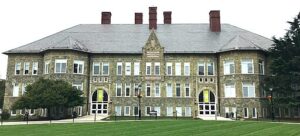
Recitation Hall at West Chester State Teachers College — Zeete, CC BY-SA 4.0, via Wikimedia Commons
8th Annual Meeting – March 26-27, 1932 (West Chester State Teachers College, West Chester, PA): At this meeting, a field trip was taken to the Pierre du Pont estate conservatories at Longwood (now Longwood Gardens). Later a presentation was given by Dr. Elmer Kraemer of the E.I. DuPont de Nemours Company on “Present Trends in Colloid Science.” Dr. M.J. Babb of the University of Pennsylvania also gave a talk on “David Rittenhouse.”
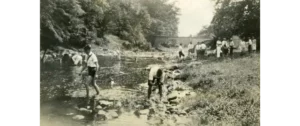
Summer Meeting of PAS at Wolf Creek near Slippery Rock, PA in 1932 – PA Geological Survey – Public Domain.
Summer Meeting – July 23, 1932: The Academy met at Slippery Rock in Butler County to look at areas of natural interest.
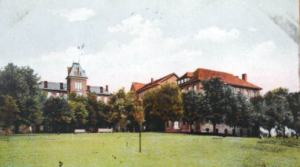
Juniata College — 1907 Rotograph Postcard, cropped, Public domain, via Wikimedia Commons
9th Annual Meeting – April 14-15, 1933 (Juniata College, Huntingdon, PA): There is no information on this meeting.
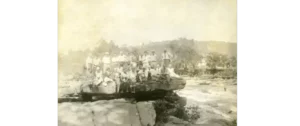
PAS Summer Meeting at Ohiopyle in Fayette County, PA in 1933 – PA Geological Survey – Public Domain.
Summer Meeting – August, 1933: This meeting was held at Ohiopyle in Fayette County, PA.

Albright College — [1], Public domain, via Wikimedia Commons
This meeting was the location of the first meeting of the newly formed, Pennsylvania Junior Academy of Science (PJAS). The meeting was called to order by acting President, Karl F. Oerlein. The Constitution of the Junior Academy of Science was also read and accepted.
Summer Meeting – August 10, 1934: Academy members met at Mount Gretna where the Cornwall mine was visited and flora and fauna in the area was observed.

Dickinson College — Tomwsulcer, CC0, via Wikimedia Commons
11th Annual Meeting – April 19-20, 1935 (Dickinson College, Carlisle, PA): At this meeting, Dr. William Walter Cort, of Johns Hopkins University, spoke on “Biological Studies of Human Parasites,” which focused on hookworm disease and its related problems. PAS President Samuel H. Derickson, spoke on the “First Decade of the Pennsylvania of Science” during this meeting as well.
Summer Meeting – August 9-10, 1935: Academy members met on August 9th at Tannersville in the Pocono Mountains to visit a “quaking bog.” Later that evening, a presentation was given at East Stroudsburg High School. On August 10th, members toured the geology of the Stroudsburg district.
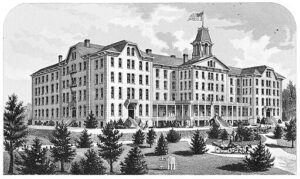
Indiana State Normal School — Bailey, Banks & Biddle, Philadelphia, Public domain, via Wikimedia Commons
12th Annual Meeting – April 10-11, 1936 (Indiana University of PA, Indiana, PA): A highlight of this meeting was a proposal on the minimum requirements of science teachers in Pennsylvania given by Dr. John Johnson, which was voted on unanimously. PAS President, Dr. Edgar Wherry, of the University of Pennsylvania, presented on “Reflections of the Origin of Life.”
Summer Meeting – August 14-15, 1936: Academy members met in Somerset, PA on August 14th and split into two groups. One group went to a virgin hemlock forest near Bucktown, while another group looked at rock formations in the gorge of the Casselman River. The evening meeting was held at the Ferner Hotel, where a number of presentations were given. On August 15th, a field trip was held to Negro Mountain where the flora and geology was observed and a CCC camp was visited.

Library at Franklin and Marshall College — Smallbones, CC0, via Wikimedia Commons
13th Annual Meeting – March 26-27, 1937 (Franklin and Marshall College, Lancaster, PA): This meeting was held jointly with PJAS and the Lancaster Branch of the American Academy for the Advancement of Science. Dr. F.R. Moulton, Secretary-elect of the American Association for the Advancement of Science delivered a presentation on “Science.”
Summer Meeting – August 14-15, 1937: Academy members met at Leonard Harrison Park in Tioga County on the afternoon of August 14th to look at the geology, flora, and fauna of the “Grand Canyon of Pennsylvania.” The evening was spent around a campfire. August 15th was spent looking at the park and other geological places of interest including Wellsboro Junction and the watershed divide between the St. Lawrence watershed (Genessee River), Mississippi River watershed (Allegheny River), and the Atlantic watershed (Susquehanna River). An ice mine in Sweden Valley was also visited.
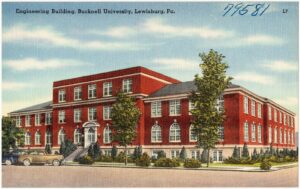
Engineering Building at Bucknell University — Engineering Building (1930-1945) – Bucknell University – Public Domain – Mebane Greeting Card Company
14th Annual Meeting – April 15-16, 1938 (Bucknell University, Lewisburg, PA): On August 14, 1938 the executive meeting was held at the Hotel Lewisburger (this is apparently one of the first executive meetings before time of the annual meeting). On the evening of August 15th, a joint meeting was held with PAS and PJAS. PAS President, George Ashley, presented on “How old is Man?”
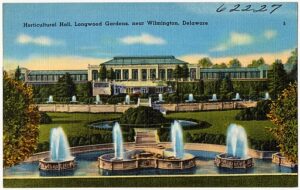
Horticultural Hall at Longwood Gardens — Tichnor Brothers, Publisher, Public domain, via Wikimedia Commons
Summer Meeting – August 12-13, 1938: Academy members met at the Columbia Avenue park in Coatesville, PA (Chester County) during the afternoon of August 12th. From here they went to Longwood Gardens and then to Newlin Barrens (a serpentine barren) to see one of the stones used by Charles Mason and Jeremiah Dixon to establish the Mason-Dixon line. Later that evening they met at the YWCA where they were met by the mayor of Coatesville. On August 13th, the group met at Westtown School and looked at more serpentine barrens and an old chromium mine.
15th Annual Meeting – April 7-8, 1939 (Pennsylvania State University, State College, PA): On April 6th, the executive committee met in the dining room of the Nittany Lion Inn. On the evening of April 7th, a dinner was held in the Nittany Lion Inn where a presentation was given by Arthur B. Cleaves of the Pennsylvania Turnpike Commission, who spoke on “Pennsylvania’s All-Weather Highway.”
Summer Meeting – August 11-13, 1939: Academy members met at the Makoma Inn in LaPorte, Sullivan County. On August 11th, they went to Haystock Rocks to see geologic formations along Loyalock Creek. That evening a meteor shower and the northern lights were viewed. August 12th was spent in the Loyalsock Creek gorge looking at ferns, Lincoln Falls, and a bog called Lost Lake. August 13th was spent at Eagles Mere, High Knob, and the Keystone State Observatory.
Go to Chapter 5: Pennsylvania Academy of Science in the 1940s

